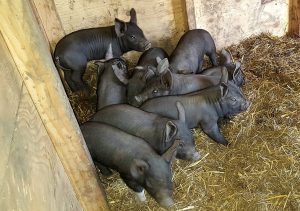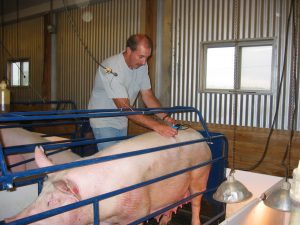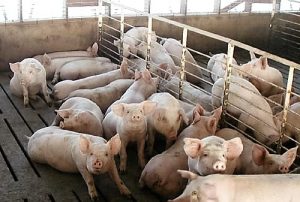 Introduction to Swine Production: The swine production industry in Washington State varies in they type of defined operations that exist. Operations vary from large to small and confinement to pasture raised. Both are viable options and have positives and negatives. Determining the type of operation is integral to your success raising swine on your property. The type of operation could be based on the amount of land that you own or have access to, your customer base, and/or your personal philosophies (animal care, environment, farming type –organic, natural, etc.). In other words determining which type of operation will depend on your lifestyle and beliefs. Like other livestock production, swine production takes into consideration many avenues that transcend animal care and management, sustainable production practices, environmental concerns, etc. Additionally, many opportunities exist in raising, processing and subsequently marketing of products from swine production. These opportunities fit either a conventional system (more traditional in approach) or a niche. Determining your marketing goal and building your operation around that will result in more success.
Introduction to Swine Production: The swine production industry in Washington State varies in they type of defined operations that exist. Operations vary from large to small and confinement to pasture raised. Both are viable options and have positives and negatives. Determining the type of operation is integral to your success raising swine on your property. The type of operation could be based on the amount of land that you own or have access to, your customer base, and/or your personal philosophies (animal care, environment, farming type –organic, natural, etc.). In other words determining which type of operation will depend on your lifestyle and beliefs. Like other livestock production, swine production takes into consideration many avenues that transcend animal care and management, sustainable production practices, environmental concerns, etc. Additionally, many opportunities exist in raising, processing and subsequently marketing of products from swine production. These opportunities fit either a conventional system (more traditional in approach) or a niche. Determining your marketing goal and building your operation around that will result in more success.
Swine Production and Management: Swine production can vary depending on the type of operation. The type of production operation will dictate management decisions such as feed, housing, land and environmental management, animal care, and may define marketing channels (organic, all natural, pasture raised, grain-fed, etc.,). These are all supported by the methods that you choose to raise your hogs. Understanding the goals of your swine operation and the type of hogs (breed, classification, etc.) you choose to raise is paramount to the success of your operation. Many large swine operations are confinement based and have many environmental controls put in place that assure air quality and a healthy life style are met. The type of operation that you choose could impact other lifestyle choices in the future. Having a clear understanding of the type of operation that you are putting in and infrastructure that it will take to execute will minimize surprises for you and your family.
Swine production can vary depending on the type of operation. The type of production operation will dictate management decisions such as feed, housing, land and environmental management, animal care, and may define marketing channels (organic, all natural, pasture raised, grain-fed, etc.,). These are all supported by the methods that you choose to raise your hogs. Understanding the goals of your swine operation and the type of hogs (breed, classification, etc.) you choose to raise is paramount to the success of your operation. Many large swine operations are confinement based and have many environmental controls put in place that assure air quality and a healthy life style are met. The type of operation that you choose could impact other lifestyle choices in the future. Having a clear understanding of the type of operation that you are putting in and infrastructure that it will take to execute will minimize surprises for you and your family.
The following links will aid new or established producers understanding basic swine production. Meeting the basic needs as defined in swine production and management is paramount to good swine stewardship.
- Agriculture Alternatives – Swine Production. 2001. K. Kephart, G. Greaser, J. Harper, and H. Moore. Pennylvania State University Extension Publication.
- Profitable Pork: Alternative Strategies for Hog Producers. 2003. Published by the Sustainable Outreach Network, USDA-SARE
- Managing Market Pigs in Hoop Structures. April 2010. Honeyman, F. Koenig, J. Harmon, D. Lay, J. Kliebenstein, T. Richard, and M. Brum. eXtension article.
Swine Nutrition:  Understanding swine nutrition will assure that you are meeting the needs of animals in your care. Understanding the components of a feed that help it fit a particular stage of swine production is key to meeting the hogs specific requirements. Each stage of production in a growing hog as well as mature breeding animal will require different protein, fat and carbohydrate levels available in a specific feed. In addition to the standard components of a mixed ration, supplements or additive feeds may improve production but can come at a cost. Additionally, these items can boost production resulting in more efficient gain resulting in reduced cost of production. There are a number of swine nutritional programs that one can follow. They look at point of production as a consideration and diets are then adjusted accordingly. Formulated swine feeds from some of the more popular feed companies can make things easy when your first starting out, however these are formulated for the most common hog needs and may not be specific to your operation. Custom feeds working with a reputable feed mill and nutritionist will allow you to optimize your program for the most efficient nutritional program. Assure that certain essential items are covered in the ration and you are dealing with a nutritionist that is current on swine nutritional requirements and feed industry regulations.
Understanding swine nutrition will assure that you are meeting the needs of animals in your care. Understanding the components of a feed that help it fit a particular stage of swine production is key to meeting the hogs specific requirements. Each stage of production in a growing hog as well as mature breeding animal will require different protein, fat and carbohydrate levels available in a specific feed. In addition to the standard components of a mixed ration, supplements or additive feeds may improve production but can come at a cost. Additionally, these items can boost production resulting in more efficient gain resulting in reduced cost of production. There are a number of swine nutritional programs that one can follow. They look at point of production as a consideration and diets are then adjusted accordingly. Formulated swine feeds from some of the more popular feed companies can make things easy when your first starting out, however these are formulated for the most common hog needs and may not be specific to your operation. Custom feeds working with a reputable feed mill and nutritionist will allow you to optimize your program for the most efficient nutritional program. Assure that certain essential items are covered in the ration and you are dealing with a nutritionist that is current on swine nutritional requirements and feed industry regulations.
- The Kansas State Nutrition Guide October 2007. Joel M. DeRouchey, Steve S. Dritz, Robert D. Goodband, Jim L. Nelssen, and Mike D. Tokach.
Swine Production Facilities – housing, fencing, equipment, etc.:  Proper swine care includes the environment that we house and contain the animals in. This environment will provide comfort and safety for the hogs and caretakers alike. Hogs can be raised in a number different environments ranging from confinement operations with a controlled system to pasture based operations or a combination of both. The type of operation and the type of hogs that you choose to raise may help you determine the appropriate environment. Further the amount of time that you dedicate to the operation may also impact the type of environment that you wish to raise your hogs in. Areas of concern can be looked at with each environment type or combination. Concerns such as air quality in a confinement operation and proximity to riparian areas in a pasture-based system are valid concerns needing to be addressed. Regardless of the type of operation or system that you choose to raise your hogs, assure that you are meeting the animals’ basic needs and that you are reducing the effect on the environment that it is in and near.
Proper swine care includes the environment that we house and contain the animals in. This environment will provide comfort and safety for the hogs and caretakers alike. Hogs can be raised in a number different environments ranging from confinement operations with a controlled system to pasture based operations or a combination of both. The type of operation and the type of hogs that you choose to raise may help you determine the appropriate environment. Further the amount of time that you dedicate to the operation may also impact the type of environment that you wish to raise your hogs in. Areas of concern can be looked at with each environment type or combination. Concerns such as air quality in a confinement operation and proximity to riparian areas in a pasture-based system are valid concerns needing to be addressed. Regardless of the type of operation or system that you choose to raise your hogs, assure that you are meeting the animals’ basic needs and that you are reducing the effect on the environment that it is in and near.
- Minimizing Odor from Swine Manure. January 2003. Heather Harris, C. M. Wood, Virginia Cooperative Extension.
Swine Business Management and Marketing:  As with any other operation a swine operation is only effective if you decide to run it and manage it like a valid business. Even if this is a hobby, it is nice to be able to recoup your costs at the end of the day. Knowing how to budget properly and plan will make it easier to determine where profit margins lie versus those items that are costly. Many marketing options exist for Small Farms in Washington. Although many small farms are looking for alternative marketing options, some choose to enter the conventional markets either through auction channels, buy days, feedlots, packers, etc., as a result of ease. Niche’ markets and direct marketing can be rewarding. Having said that some are frustrated with establishing a niche market resulting in disappointment. Yet direct marketing is an avenue for consumers who wish to know more about their food and have exercised their right to request certain label claims. Tag lines such as organic, local, all natural, etc. meeting the defined standards set by USDA will peak consumers interest in the market place. Further breed (Berkshire) and category (heritage breeds) specific may also offer avenues for marketing when it comes to swine production.
As with any other operation a swine operation is only effective if you decide to run it and manage it like a valid business. Even if this is a hobby, it is nice to be able to recoup your costs at the end of the day. Knowing how to budget properly and plan will make it easier to determine where profit margins lie versus those items that are costly. Many marketing options exist for Small Farms in Washington. Although many small farms are looking for alternative marketing options, some choose to enter the conventional markets either through auction channels, buy days, feedlots, packers, etc., as a result of ease. Niche’ markets and direct marketing can be rewarding. Having said that some are frustrated with establishing a niche market resulting in disappointment. Yet direct marketing is an avenue for consumers who wish to know more about their food and have exercised their right to request certain label claims. Tag lines such as organic, local, all natural, etc. meeting the defined standards set by USDA will peak consumers interest in the market place. Further breed (Berkshire) and category (heritage breeds) specific may also offer avenues for marketing when it comes to swine production.
- Expanding Swine Production in Eastern Washington. December 1997. Thomas Platt. Washington State University.
Photo Credits: Introduction and Production & Management photos courtesy of J. Cowan, WSU. Remaining photos courtesy of Paul Kuber, WSU (formerly of Ohio State University Extension).